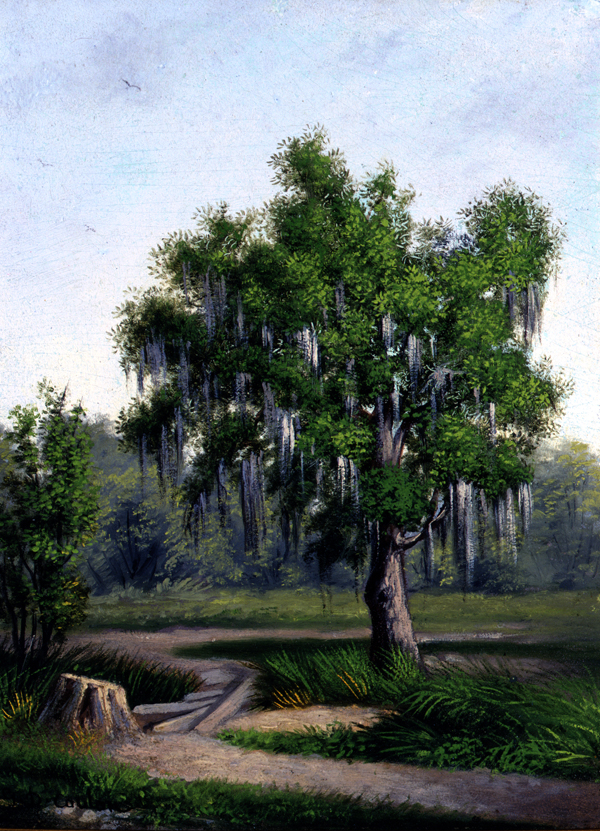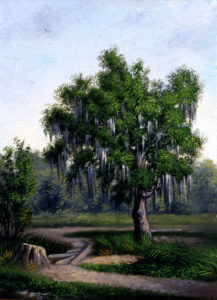New Orleans City Park
One of the largest urban parks in the United States, New Orleans' City Park is home to many cultural and recreational attractions including the New Orleans Museum of Art, the Botanical Garden, golf courses, tennis courts, City Bark dog park, Tad Gormley stadium, and several lagoons.

Courtesy of Roger H. Ogden Collection
In The City Park. Coulon, George David (Artist)
For the first half of the nineteenth century, the site that would later become New Orleans’ City Park was the Allard Plantation. In 1850 its owner, wealthy businessman/planter John McDonogh, died and left the property jointly to his native city, Baltimore, and his adopted city, New Orleans. After gaining clear title to the land in 1858, the City of New Orleans reserved the property for a park, but it remained undeveloped and unused for years. Over time the city subdivided and sold parcels, only to reacquire many of them later to assemble a contiguous parcel.
An article in the Daily Picayune on March 13, 1892, recounts that the city had engaged the “designers of New York’s Central Park” to draw plans. Actually, those contacted in 1872 to draw plans for the site were John Bogart and John Y. Culyer, staff engineers in Frederick Law Olmsted’s office; it was Olmsted who, along with architect Calvert Vaux, designed New York City’s famed park. Both Bogart and Culyer had, however, worked on the construction of large parks Olmsted designed. Bogart visited the New Orleans site, made field notes about site conditions, and delivered a “Study Plan.” For their efforts, the “landscape architects and engineers” received half their fee, but the park’s board refused to pay the rest, claiming their plan was inadequate. In late 1873 Bogart and Cuyler sued for the remainder. Though the lower court sided with the board, the plaintiffs appealed and prevailed in the Louisiana’s Supreme Court.
The importance of this episode is the fact that community decision makers, in the early 1870s, took steps to employ design services for a local urban park from landscape architects associated with New York’s Central Park—the national standard for urban parks—as the 1892 newspaper article claims. Interestingly, the 1872 date precedes involvement by the Olmsted Brothers office in Audubon Park by more than two decades. The insubstantial plan and resulting legal activity dampened enthusiasm among board members for initiating improvements. Following the lawsuit, as the 1892 newspaper article continues, “[N]othing more was heard of the park. People forgot where it was…” and it remained undeveloped until 1891, when civic leaders organized the City Park Improvement Association, a private nonprofit corporation that acquired permission from the State of Louisiana to manage the park.
Park Development and Growth
Significant improvements, including a classically inspired band stand and peristyle, a rectangular dance pavilion, designed by local architects, began and continued into the twentieth century’s first decades. The park’s entrance features a traffic circle with an equestrian statue of Confederate Gen. P. G. T. Beauregard (sculpted by Alexander Doyle in 1915), monumental pylons, and a strong axis terminating in the Beaux-Arts New Orleans Art Museum. These features are arguably the city’s most impressive representation of the City Beautiful movement, a style of civic architecture popularized by Chicago’s Columbian Exposition of 1893.
By the 1920s the park had increased to 1,300 acres and, in 1929, the firm of Bennett, Parsons, and Frost of Chicago was selected (over the Olmsted Brothers) to develop a master plan. Between 1934 and 1940, projects of the Works Progress Administration totaling $13 million were completed in the park, with more than 14,000 workers building projects such as golf courses, lagoons (in the shapes of Lake Ponchartrain and Lake Bourne), infrastructure, bridges, a stadium, and the botanical garden. Much of the construction was cast concrete, allowing workers to create objects such as benches, light standards, and other garden features. Particularly notable are numerous bridges featuring figural, low relief art deco details. With expansive open spaces, naturalistic plantings, lagoons, new infrastructure and architectural features, the park began to resemble romantic parks of the past.
The Botanical Garden features the work of architect Richard Koch, landscape architect William Wiedorn, and artist Enrique Alferez. Koch guided early efforts to record and preserve historic Louisiana architecture, and Wiedorn was one of the city’s first landscape architects. Wiedorn moved to New Orleans in the early 1930s to design City Park’s golf courses and stayed, revising plans drawn by Bennett, Parsons and Frost and designing the Botanical Garden’s “garden rooms,” including its rose garden. Alferez was a colorful and prolific Mexican sculptor who created designs for functional objects in the park in general, such as bridges and light standards, and decorative objects for the Botanical Garden in particular, including benches, sculptures, gates, and other features. In fact, City Park holds the largest collection of Alferez’s multifaceted work, concentrated in and around the Botanical Garden.
In 2005, City Park suffered extensive flood damage following Hurricane Katrina, losing trees, buildings, and equipment. The Botanical Garden’s board quickly committed to replanting (only its oaks survived) and replacing irrigation and lighting systems—tasks accomplished largely with volunteers and donated supplies. Within weeks, it had become an oasis and a place of healing and inspiration for the devastated community. Extensive post-hurricane improvements to the park have generally followed a master plan intended to enhance the park’s character and increase its popularity; the plan was released just weeks before the hurricane struck and the levees failed. The Trust for Public Land, for instance, funded a project near the entrance that reconfigured the existing lagoon and encircled it with a pathway. Tennis courts have been relocated near the Popp Memorial Fountain, enabling the creation of a Great Lawn between the Botanical Garden and the peristyle. Improvements continue, and now more than ever before, City Park has become a major attraction for metropolitan area residents.
